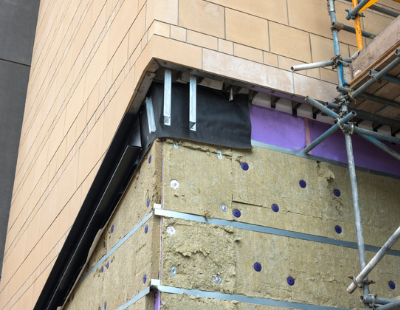Analysis from the financial consultant, based on a sample of 670,000 mortgage loans, found that:
-
Hotspots for flats are London (28.5%), Glasgow (3.7%), and Edinburgh (3.2%). East London has the most flats, accounting for nearly 7.5% of all UK-wide flats.
-
House prices would need to decline by more than 20% of their current value for a meaningful number of mortgage borrowers to end up in negative equity.
-
Fire safety repair bills (even after accounting for differences in labour costs) may not be proportional to the property value. This means that borrowers in the northern UK where property values are cheaper could have repair bills which, relative to their property value, are higher than in London.
Ketan Thaker, head of European RMBS and Covered Bonds, comments: “Borrowers are likely to face higher mortgage costs because of an increase in their mortgage loan-to-value ratios, either as result of reduced flat values or additional debt undertaken to fund repairs.
“DBRS Morningstar’s analysis shows that, assuming that borrowers can remortgage, they may still face higher monthly payments in most cases. Furthermore, the impact could be much more severe for borrowers if they cannot get a new mortgage and have to move onto the lender’s standard variable rates, which tend to be higher.”
You can read the commentary in full here.

MetroPM welcomes new guidance on valuing high-rise flats with cladding
Property management operator MetroPM has welcomed a new valuation process issued by the Royal Institution of Chartered Surveyors (RICS) over valuing high-rise properties with cladding.
The industry-wide guidance is titled ‘Valuation of properties in multi-storey, multi-occupancy residential buildings with cladding’, and follows consultation with valuers, leaseholders, lenders, fire safety experts and government.
Matthew Arnold, managing director of MetroPM, explains that the paper had been agreed with the Building Societies Association and UK Finance and will clarify which types of properties will or will not require additional inspections due to concerns about fire safety.
He says: “We welcome this guidance which will help to create clarity and consistency about when a valuer is not required to request further investigation of cladding before valuing a property in a building of multiple occupation.”
“Importantly, it makes it clear that where a valuer or lender can establish that the building owner has met the advice in the consolidated advice note, an EWS1 form should not be required. An EWS1 form would also not be required for a building that is over 18 metres that has a valid building control certificate in place.”
Arnold mentions that MetroPM, which has offices in Birmingham and Cheltenham, is currently dealing with blocks where cladding needs to be removed and so would find the advice ‘extremely useful’.
The guidance details that an EWS1 form will only be required for the following:
-
Buildings over six storeys with cladding or curtain wall glazing, or vertically stacked balconies made from or connected by combustible materials (such as timber).
-
Buildings of five or six storeys where there is significant cladding (covering approximately a quarter of the building or more), or there are ACM, MCM or HPL panels on the building, or there are vertically stacked balconies made from or connected by combustible materials.
-
Buildings of four storeys or less, if there are ACM, MCM or HPL panels on the building.
Arnold adds: “This guidance details exactly when an EWS1 form will be required for valuations, and this will help to simplify the process, enabling more people to buy and sell homes and re-mortgage in high-rise buildings.”
Scottish cladding crisis event calls for transparency for residents
Edinburgh legal firm Watermans Legal is set to address the continued confusion surrounding Scotland’s cladding crisis with a virtual event for residents.
This comes as demand grows for the Scottish Government to allocate funds to homeowners trapped in their unsellable homes due to combustible cladding.
A £100 million pot of funding was made available to the Scottish Government last year to help tackle the crisis, with mounting pressure on the Scottish Housing Minister, Kevin Stewart, to put an action plan into place to use the funds.
The virtual event – bringing together leading experts from Watermans Legal, Fire Risk Assessment (Scotland) Ltd, J&E Shepherd Chartered Surveyors and Residential Surveyor and M&W Mortgages – will address how cladding issues can affect selling, buying and the mortgaging of properties.
The importance of obtaining and instructing an External Wall Fire Risk Review (EWS1 form), which confirms that a building does not pose a fire risk, will also form a key part of the event’s agenda.
Shawn Wood, a solicitor at Watermans Legal who will be speaking at the event, comments: “The topic of cladding is so closely aligned with England. There’s not nearly as much focus on how it affects Scottish residents.”
“We’re receiving a growing number of calls from people with concerns about their properties and the incurring costs which is why we felt it was necessary to host this event. It’s an opportunity to gather Scotland’s cladding experts and share our knowledge with the public.”
Many people in Scotland who are affected by the cladding crisis have been left confused, with no helpful responses despite huge company profits from builders and the construction industry.
Wood says residents have inherited these problems through no fault of their own.
“Many people are feeling trapped as their homes are effectively worthless if a Home Report returns ‘category threes’ for their external main walls,” he adds. “Obtaining an External Wall Fire Risk Review form, which demonstrates to a buyer that there isn’t a fire risk, can also be timely and expensive due to a shortage of professionals with the necessary qualifications to carry out these specialist reports.”
“If all homeowners were to fix the problem of combustible cladding it could cost tens of thousands of pounds per property which leave many concerned that they will be left to foot the bill if their building is found to have combustible cladding. With the Government’s plan to support Scotland still to be announced, we want to offer any advice that we can to help alleviate people’s fears.”
The Cladding Crisis in Scotland online event takes place on Thursday March 18 from 6-8pm. Interested parties can sign up for free here.
Can the government resolve the cladding issue by 2023? Only 1% think so
Only 1% of industry professionals have the utmost faith in the government to resolve the cladding issue within the next two years, a webinar poll undertaken by Countrywide Surveying Services (CSS) has revealed.
The response emerged at CSS’ inaugural webinar series which revolved around a panel debate on cladding. Over 500 people registered for the webinar with 350 lenders, brokers, surveyors and other property professionals actively engaging with the session.
The panel included representatives from a number of major lenders and the Royal Institution of Chartered Surveyors (RICS) who joined John Baguley and Matthew Cumber from Countrywide.
The poll was taken during the webinar and posed the question: How much faith do you have in the government (north and south of the border) to resolve the cladding issue within the next two years?
Some 256 attendees voted with 50% saying they were ‘not confident’, 34% were ‘unsure’, 15% suggested that they were ‘somewhat confident’ whilst only 1% opted for the ‘very confident’ option.
Matthew Cumber, managing director of Countrywide Surveying Services, says: “Cladding is an issue which has generated huge amounts of column inches and concern across the industry. As one of the largest surveyor workforces in the UK, we have a duty to raise awareness and help educate property professionals on all aspects of residential property valuations.”
“This is an area which needs immediate action and clarity. I understand the concerns of industry professionals when it comes to the resolution of cladding-related issues and it demonstrates how a joined-up, responsible and comprehensive approach is urgently needed from the government, backed by all links in the property chain.”
John Baguley, director of technical, risk and compliance at Countrywide Surveying Services, adds: “We always knew that cladding would be a hot topic for our first webinar, but who knew it would be this popular. A big thanks to our fellow panellists and I sincerely hope that between us, the lending community and RICS we can remove the 18ft ruling so that no matter the type or size of property, they can all be assessed fairly and those that require remedial work are treated equally.”
.png)
ALEP’s annual lecture on Cladding continues online success
The Association of Leasehold Enfranchisement Practitioners (ALEP) welcomed more than 180 leasehold professionals to its virtual Annual Spring Lecture this month.
The lecture, built upon the success of ALEP’s virtual conference in October 2020, offered both insight and practical advice to professionals working in the leasehold sector on March 3 and 4.
The discussion was centred on the cladding and fire safety crisis that has emerged in the wake of the fire at Grenfell Tower and the subsequent effects on the practice of those working in leasehold enfranchisement.
Mark Chick, ALEP director and host of the lecture, says: “We have been careful to treat this delicate topic with the respect that it deserves and have wanted to deal with the issues sensitively. We did not take on the topic of cladding and enfranchisement lightly, but selected it because our members are facing an increasing need to adapt their practice to the emerging issues.”
“We have been pleased with the success of the virtual format and the outstanding line-up of speakers who have offered an insightful overview of the ever-changing situation for our members.”
ALEP welcomed Justin Bates from Landmark Chambers, Dr Jonathan Evans from Ash & Lacy Building Systems, and Dr Nigel Glen from the Association of Residential Managing Agents (ARMA). All three have been actively involved in the response to the cladding crisis, offering evidence and advice to the government since the Grenfell Tower fire.
Day one offered a background to the cladding crisis and the issues facing the wider housing sector. In a lecture focused on insight and understanding, the speakers explained the details of cladding installation, the cost of waking watches and the potential for future legislation, among a range of different topics.
Day two focused more specifically on the impact the cladding crisis has had on leasehold enfranchisement, providing opinions from both legal and valuation experts.
James Sandham from Selborne Chambers, Anna Favre from Cripps Pemberton Greenish, and Chris Macartney from Bishop & Sewell opened the session with legal considerations.
Fiona Haggett FRICS head of valuation from Barclays UK gave a presentation that considered the impact that the crisis around fire safety issues has had upon the mortgage market for both borrowers and lenders.
The lecture concluded with a roundtable of experts including Colin Horton from Hortons Valuers, Mark Wilson from myleasehold, Richard Murphy from Richard John Clarke and Clive Scrivener from Scrivener Tibbatts joined by barrister, Piers Harrison of Tanfield Chambers. In a lively discussion, the panel debated the difficulty of offering accurate valuations when accounting for potential future remediation before answering questions posed by members.
Chick concludes: “We are very grateful to all the speakers for giving their time and sharing their knowledge. I fear the cladding issue will not be resolved quickly so it was extremely useful to be able to offer ALEP members an intensive course on the background, intricacies and considerations of what is a very complicated topic.”
We recently covered other pressing news on cladding, which you can view here.





.png)





.png)










Join the conversation
Be the first to comment (please use the comment box below)
Please login to comment